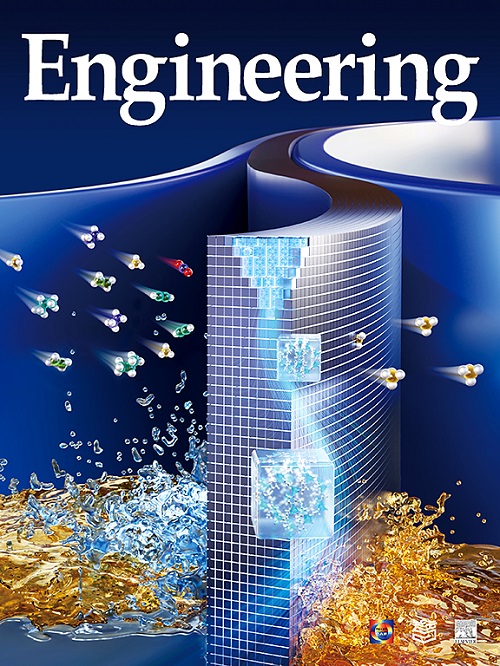Continuous Joule Heating for Scalable and General Fusion Ternary Metal Oxides with Triple-Active Fenton-Like Activity
IF 10.1
1区 工程技术
Q1 ENGINEERING, MULTIDISCIPLINARY
引用次数: 0
Abstract
Multimetal oxide with asymmetric atomic sites offers potential solutions for Fenton-like reactions, while their pilot-scale synthesis remains challenging. Herein, we develop a continuous flash Joule heating method using a programmable logic controller with robotic arms to accomplish proof-of-concept of scalable production. The pilot-scale product (178.3 kg·h−1·m−2 electrode) of fusion ternary metal oxides was achieved for flow-through water treatment. Integrating multiple reaction electrodes with respective independent power further outlined an increased production path. Experiments and density functional theory calculations proved that fusion CuVFeO structure achieved the dual functionality of organics adsorption on Cu sites and peroxydisulfate activation on Fe sites. The synergistic reaction can be strengthened by V doping endowed with a d band center, leading to an increased Fe Bader charge. Therefore, triple site effects shorten the reaction distance between free radicals (SO4•− and •OH) and organics, enhancing free radicals’ utilization and production efficiency. CuVFe secures superior performance during long-term operations (1455 min) in a continuous flow-through device. flash Joule heating characterization determined multi transition metals (CuVFe, CoVFe, MgVFe) can be generally synthesized with a superior catalytic performance. Undoubtedly, continuous flash Joule heating sheds light on developing advanced oxidation materials for pilot-scale wastewater treatment.具有三活性类芬顿活性的可扩展和一般熔融三元金属氧化物的连续焦耳加热
具有不对称原子位的多金属氧化物为类芬顿反应提供了潜在的解决方案,但它们的中试合成仍然具有挑战性。在此,我们开发了一种使用带有机械臂的可编程逻辑控制器的连续闪光焦耳加热方法,以完成可扩展生产的概念验证。在流式水处理中获得了熔合三元金属氧化物的中试产品(178.3 kg·h−1·m−2电极)。将具有各自独立功率的多个反应电极集成,进一步概述了增加的生产路径。实验和密度泛函理论计算证明,融合CuVFeO结构实现了有机吸附Cu位点和过硫酸盐活化Fe位点的双重功能。带d带中心的V可以增强协同反应,导致Fe Bader电荷增加。因此,三位点效应缩短了自由基(SO4•−和•OH)与有机物的反应距离,提高了自由基的利用率和生产效率。在连续流动装置中,在长期操作(1455分钟)中,CuVFe保证了卓越的性能。闪光焦耳加热表征确定了多过渡金属(CuVFe, CoVFe, MgVFe)一般可以合成具有优越催化性能的金属。毫无疑问,连续闪光焦耳加热有助于开发中试废水处理的高级氧化材料。
本文章由计算机程序翻译,如有差异,请以英文原文为准。
求助全文
约1分钟内获得全文
求助全文
来源期刊

Engineering
Environmental Science-Environmental Engineering
自引率
1.60%
发文量
335
审稿时长
35 days
期刊介绍:
Engineering, an international open-access journal initiated by the Chinese Academy of Engineering (CAE) in 2015, serves as a distinguished platform for disseminating cutting-edge advancements in engineering R&D, sharing major research outputs, and highlighting key achievements worldwide. The journal's objectives encompass reporting progress in engineering science, fostering discussions on hot topics, addressing areas of interest, challenges, and prospects in engineering development, while considering human and environmental well-being and ethics in engineering. It aims to inspire breakthroughs and innovations with profound economic and social significance, propelling them to advanced international standards and transforming them into a new productive force. Ultimately, this endeavor seeks to bring about positive changes globally, benefit humanity, and shape a new future.
 求助内容:
求助内容: 应助结果提醒方式:
应助结果提醒方式:


